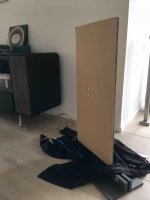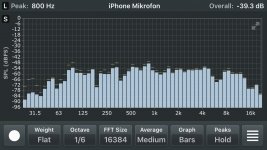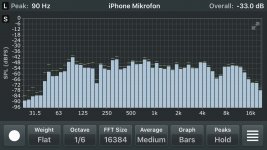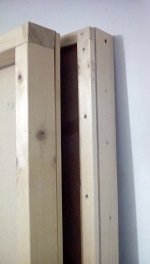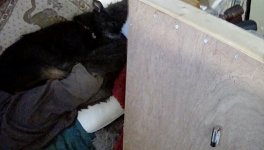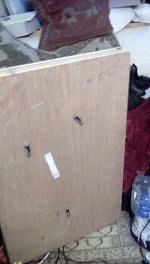... a speaker system with one subwoofer does require in my experience one more microphone to show the balanced sound, which is experienced at normal listening levels.
Thanks Burn, It should be a "illuminating " experiment ,I couldn't resit the pun..
I will keep everyone inform on the progress this summer hopefully....
Cheers
Steve
I will keep everyone inform on the progress this summer hopefully....
Cheers
Steve
Indeed a clear effect from slanting. I'll try the pausing test and then build a frame.Onni.
Looks like slanting the clamp has reduced the 15db peak to peak to 10db peak to peak!
And the main response is being held mainly within a 10db window,so a smoother response overall.
Your panel is also maintaining response way above 10k hooray!!
Did you try my method of pausing the music to hear if the panel makes a shoom sound after the music stops(panel keeps on resonating),this is a problem with large panels.
XO the panel around 300hz and see if it is still happening so bady,
As for damping,There are at least two thoughts on this ,my way would be to solidly clamp the panel in a heavy frame ,you would have the same sort of sound but louder ,but which would hopefully control the resonances better.
Or you could use foam to mount the panel onto a frame to dampen it,this would affect the sound , making it sound softer and smoother , like applying doping to a cone driver.
Obviously a frame would be needed for both,so you could experiment with both types,I would recommend a heavy rigid frame for both types,for less play in the frame.
Steve
It's a 4 mm thick pine plywood. It's cheap (25 € for 121x242 cm) and only has one good side.What's your panel material?
/Anton
yesterday one speaker on Swap (honeycomb cardboard) mounted.
The panel measures 390 x 810 x 13 mm and the weight is 480 gr. The exciter (Visaton EX 60 R / 8) is mounted slightly off the center in the diagonal. The clamp is made with MDF and one thin woolen felt jacket used for damping.
The soundstage is amazing. The sound balance I'll try to improve ; )
Pictures show the speaker with clamp, pink noise at 30' and 10' (approx)
The panel measures 390 x 810 x 13 mm and the weight is 480 gr. The exciter (Visaton EX 60 R / 8) is mounted slightly off the center in the diagonal. The clamp is made with MDF and one thin woolen felt jacket used for damping.
The soundstage is amazing. The sound balance I'll try to improve ; )
Pictures show the speaker with clamp, pink noise at 30' and 10' (approx)
Attachments
yesterday one speaker on Swap (honeycomb cardboard) mounted.
The panel measures 390 x 810 x 13 mm and the weight is 480 gr. The exciter (Visaton EX 60 R / 8) is mounted slightly off the center in the diagonal. The clamp is made with MDF and one thin woolen felt jacket used for damping.
The soundstage is amazing. The sound balance I'll try to improve ; )
Pictures show the speaker with clamp, pink noise at 30' and 10' (approx)
details about the frequency chart (10 inch distance / peak hold):
- 82.9 dB/35.5 Hz
- 41.6 dB/90 Hz
- 69.8 dB/180 Hz
- 44.1 dB/315 Hz
- 64.6 dB/5.6 kHz
- 65.5 dB/14 kHz
100ohms
The dip at 180hz can probably be filled by sliding something like an AA battery around the panel surface until the cancellation spot is found,wouldn't be surprised if this was going towards the top left of right corners from the exciter ,but it's different for every panel type,so check the whole panel.
The dip at 5.6k might be filled by using my strip of paper technique,by sliding a 1inch strip of paper across the exciter central point,usually when one edge of the strip of paper, is on or near the centre of the exciter coil,while monitoring the response in the exciter area ,this will also alter the HF,try to get a flat response.
Hope this is of some help.
Steve
The dip at 180hz can probably be filled by sliding something like an AA battery around the panel surface until the cancellation spot is found,wouldn't be surprised if this was going towards the top left of right corners from the exciter ,but it's different for every panel type,so check the whole panel.
The dip at 5.6k might be filled by using my strip of paper technique,by sliding a 1inch strip of paper across the exciter central point,usually when one edge of the strip of paper, is on or near the centre of the exciter coil,while monitoring the response in the exciter area ,this will also alter the HF,try to get a flat response.
Hope this is of some help.
Steve
Last edited:
Hi Steve100ohms
The dip at can probably be filled by sliding something like an AA battery around the panel surface until the cancellation spot is found,wouldn't be surprised if this was going towards the top left of right corners from the exciter ,but it's different for every panel type,so check the whole panel.
The dip at 5.6k might be filled by using my strip of paper technique,by sliding a 1inch strip of paper across the exciter central point,usually when one edge of the strip of paper, is on or near the centre of the exciter coil,while monitoring the response in the exciter area ,this will also alter the HF,try to get a flat response.
Hope this is of some help.
Steve
Thank you for your feedback and advices, highly appreciated: )
Will check it out next week among other options. Your ‚spledge paper-method‘ is definitely on top of the options list. Thought as well to build a frame for hanging the panel to get a comparison.
Question: How do you produce a mp4 file. With my iPhone I could record a voice memo as m4a file.
By the way, your drum file doesn’t open with my mac, the piano-file worked good.
Eric
100ohms.
I also have trouble playing on drum on my Samsung phone and old kindle,but plays on win 10 and old hudle and kindle fire tablet,must be some sort of copy restriction maybe ?
I converted wave from audacity to mp4 with VLC in win10,it's a free software,I tried various other software that didn't work .
Steve
I also have trouble playing on drum on my Samsung phone and old kindle,but plays on win 10 and old hudle and kindle fire tablet,must be some sort of copy restriction maybe ?
I converted wave from audacity to mp4 with VLC in win10,it's a free software,I tried various other software that didn't work .
Steve
100ohms.
The frame I use is quite substantial 2 1/2 x 1/12 inch studwork ,it was very cheap,a more expensive harder wood would have been better.
Extra bracing on the larger panels(first pic).
So this could be a problem for you?
Although if you have enough clamps you could test?
Steve
The frame I use is quite substantial 2 1/2 x 1/12 inch studwork ,it was very cheap,a more expensive harder wood would have been better.
Extra bracing on the larger panels(first pic).
So this could be a problem for you?
Although if you have enough clamps you could test?
Steve
Attachments
Thank you Steve, for your information. I‘ve thought to take some leftovers (pine) which are 2‘ about or even smaller. Just for checking out. It‘s astonishing me, that you prefer hardwood. I haven’t thought about any impact on resonant force to the frame. I‘ll consider that now, for sure.100ohms.
The frame I use is quite substantial 2 1/2 x 1/12 inch studwork ,it was very cheap,a more expensive harder wood would have been better.
Extra bracing on the larger panels(first pic).
So this could be a problem for you?
Although if you have enough clamps you could test?
Steve
I‘m tending anyway to focus on smaller panels and using one KEF B139 (1. Version) in an enclosure per panel as woofer.
Eric
100ohms.
I haven't used hardwood ,but would expect it to perform better.
I'm not sure everyone gets what the frame is for,it's to reflect the sound back into the panel with as little loss as possible,a bit like the sound bouncing off hard walls.
This makes the dml modes more efficient (louder),if the frame is thin it will absorb the energy and start vibrating itself ,causing distortions,and become murky,I don't want to hear the frame,it's not part of the panel ,just a reflector.
You can't go too small with this type of panel as the panel starts to get very stiff and hard,and starts to sound like glass,even with 3ml ply,a bit of flex is good.
Large panels do have problems,once they start moving they are slow to stop,they also have more panel noise,which is not such a problem if listening at far enough distance,but not so good close up.
This is why I think large panels should be used for large rooms and small panels for small rooms.
Steve
I haven't used hardwood ,but would expect it to perform better.
I'm not sure everyone gets what the frame is for,it's to reflect the sound back into the panel with as little loss as possible,a bit like the sound bouncing off hard walls.
This makes the dml modes more efficient (louder),if the frame is thin it will absorb the energy and start vibrating itself ,causing distortions,and become murky,I don't want to hear the frame,it's not part of the panel ,just a reflector.
You can't go too small with this type of panel as the panel starts to get very stiff and hard,and starts to sound like glass,even with 3ml ply,a bit of flex is good.
Large panels do have problems,once they start moving they are slow to stop,they also have more panel noise,which is not such a problem if listening at far enough distance,but not so good close up.
This is why I think large panels should be used for large rooms and small panels for small rooms.
Steve
Hi Steve100ohms.
I haven't used hardwood ,but would expect it to perform better.
I'm not sure everyone gets what the frame is for,it's to reflect the sound back into the panel with as little loss as possible,a bit like the sound bouncing off hard walls.
This makes the dml modes more efficient (louder),if the frame is thin it will absorb the energy and start vibrating itself ,causing distortions,and become murky,I don't want to hear the frame,it's not part of the panel ,just a reflector.
You can't go too small with this type of panel as the panel starts to get very stiff and hard,and starts to sound like glass,even with 3ml ply,a bit of flex is good.
Large panels do have problems,once they start moving they are slow to stop,they also have more panel noise,which is not such a problem if listening at far enough distance,but not so good close up.
This is why I think large panels should be used for large rooms and small panels for small rooms.
Steve
Good explanation and findings, thank you. Because I find the soundstage extraordinary lovely;-) and I don‘t need more efficiency with my 8 Watts amp, I‘ll prefer as you said a non resonant stand/frame as well, open on all sides beside the floor (floorstanding ) and would like to achieve it with different methods of resonance damping.
The stiffness is really a primary challenge. The honeycomb cardboard is kind of very stiff. Therefore will checkout any cardboard types, a mix of materials and different shapes.
Eric
How is this experiment coming along.
I have the same idea in my head. I did ordered some maiylar and 3d fastbodn glue. to se what can I do with it.
How it was on your side?
Thanks.
Trying to stiffen a Mylar panel with heat shrinkage...
I cooked the panel @90 degrees C for 5 seconds on each side. You could hear a popping sound that proved to be the cells inflating and delaminating. The picture shows consolidation of the expanded air. So, don’t do it this way. Once cooled I am gonna try a heat gun instead. This won’t salvage the panel but might not heat the air in the panel as much. If not.....DML headphones.
I have the same idea in my head. I did ordered some maiylar and 3d fastbodn glue. to se what can I do with it.
How it was on your side?
Thanks.
4 days ago i had never heard of dml speakers, have been plowing through this thread and it intriges me. It is however hard to find heads n tails in it as it all Seem very experimental.
I have some prob simple questions that i hope someone Will enlighten me on.
Exciter questions
ply has low sensitivity compared to foam for example. So either live with Less output or get an exciter that Can handle more watts.
Does going up in exciter size 19-25-30-32mm degrade High frequency quality or Roll off or Both?
What decides the lowest frequency a panel Will produce?
Ben
I have some prob simple questions that i hope someone Will enlighten me on.
Exciter questions
ply has low sensitivity compared to foam for example. So either live with Less output or get an exciter that Can handle more watts.
Does going up in exciter size 19-25-30-32mm degrade High frequency quality or Roll off or Both?
What decides the lowest frequency a panel Will produce?
Ben
Welcome Ben p!
Either material combined with a subwoofer and some eq will give you very high quality sound irrespective of price. Personally I prefer ply but there are many advocates of XPS/EPS whose opinions I respect.
I would not worry too much about sensitivity. I have run a large ply panel and a tall and thin ply panels both with a single exciter and volume is not a problem. DML's work best from 100/200 Hz upwards and panel area is big for the frequency range involved. Unless you are using very low powered amps you will get plenty of volume.
I have not experienced a problem with HF from exciters themselves even with large voice coils. I have had feedback from other members of this thread, who are all super supportive by the way, that my panels are lacking in the HF range before I EQ them flat, but in practice I have not found this to be a problem as the exciter I use and the amp I use can cope with 'heavy' EQ without a problem. One of the things to look out for is the amount of energy an exciter can output so for ply panels I use exciters with larger voice coils and higher power ratings. You can use lower powered exciters with foam panels and usually they are cheaper if you are on a budget.
For perspective on the sound you can expect to get, I used to build electrostatics for years and in my experience DML's beat electrostatics hands down for a fraction of the cost.
I hope that is helpful
Burnt
Either material combined with a subwoofer and some eq will give you very high quality sound irrespective of price. Personally I prefer ply but there are many advocates of XPS/EPS whose opinions I respect.
I would not worry too much about sensitivity. I have run a large ply panel and a tall and thin ply panels both with a single exciter and volume is not a problem. DML's work best from 100/200 Hz upwards and panel area is big for the frequency range involved. Unless you are using very low powered amps you will get plenty of volume.
I have not experienced a problem with HF from exciters themselves even with large voice coils. I have had feedback from other members of this thread, who are all super supportive by the way, that my panels are lacking in the HF range before I EQ them flat, but in practice I have not found this to be a problem as the exciter I use and the amp I use can cope with 'heavy' EQ without a problem. One of the things to look out for is the amount of energy an exciter can output so for ply panels I use exciters with larger voice coils and higher power ratings. You can use lower powered exciters with foam panels and usually they are cheaper if you are on a budget.
For perspective on the sound you can expect to get, I used to build electrostatics for years and in my experience DML's beat electrostatics hands down for a fraction of the cost.
I hope that is helpful
Burnt
Last edited:
found these two panels at the bottom of a bin i was emptying,the left is a 3/12inch square ,right is a 4inch round both use a 25mm 10watt exciter similar to the one tectonic sell.
i have kept the same recording setup as before except the distance is now 1.7m.
steve
i have kept the same recording setup as before except the distance is now 1.7m.
steve
Attachments
Thx burnt,
My amps Will do just fine with heavy eq so no issue there.
Okay so ill go with a large exciter for my mains.
Living room:L20 x w17
Dml bass panels, what could i hope for of volume and extension?
Bass panels- is it plausible to get good Sound from mounting Bass panels “flat“ on my Ceiling above the mains?
I have 17 feet of unused ceiling Width, so multible large panels with multible exciters is possible.
Im aware that i need to dampen the side of the panels thats up against the ceiling.
What materiel and size of panels do Well for bass?
I have 4 x jbl2225h i could use to help the bottom end if needed, but i would prefer to Stay with “stealthy” panels if possible.
Thx for taking the time to guide me 🙂
Ben
My amps Will do just fine with heavy eq so no issue there.
Okay so ill go with a large exciter for my mains.
Living room:L20 x w17
Dml bass panels, what could i hope for of volume and extension?
Bass panels- is it plausible to get good Sound from mounting Bass panels “flat“ on my Ceiling above the mains?
I have 17 feet of unused ceiling Width, so multible large panels with multible exciters is possible.
Im aware that i need to dampen the side of the panels thats up against the ceiling.
What materiel and size of panels do Well for bass?
I have 4 x jbl2225h i could use to help the bottom end if needed, but i would prefer to Stay with “stealthy” panels if possible.
Thx for taking the time to guide me 🙂
Ben
- Home
- Loudspeakers
- Full Range
- A Study of DMLs as a Full Range Speaker
